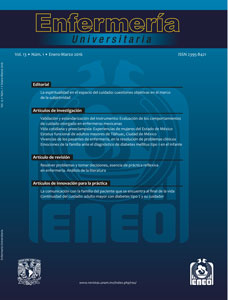Continuity of care: Aged with diabetes type 2 and their caregiver
Main Article Content
Abstract
Objective: To establish the continuity care on persons suffering from diabetes type 2 (DT2) and their caregiver following hospital discharge, through home-visit interventions which can contribute to the improvement of lifestyles.
Method: The nursing process was performed on a patient with DT2 and the corresponding primary caregiver through a nursing assessment which included the use of the 24-Diabetes Knowledge Questionnaire and the Instrument to Measure Lifestyles in patients with Diabetes Type 2. The identification of needs through the NANDA taxonomy allowed informational, relational and managerial interventions based on the Nursing Interventions Classification. The educational interventions were performed during periodic sessions under the informed consent of the participants and through an interactive methodology. The effectiveness was assessed through a final evaluation of the patient and corresponding caregiver.
Results: An increment in the level of knowledge of the illness and an improvement in the lifestyle of the person with DT2 and the corresponding caregiver, in the nutrition, physical activity, emotions, and therapeutic adherence domains were observed.
Conclusion: The continuity care on the person with DT2 is a critical tool to improve the lifestyle and level of knowledge, and to reduce the risk of complications and hospital re-entries.
Publication Facts
Reviewer profiles N/A
Author statements
- Academic society
- N/A
- Publisher
- Universidad Nacional Autónoma de México
Article Details
Dimensions citation
MÉTRICAS
Enfermería Universitaria by Universidad Nacional Autónoma de México it is distributed under the License Creative Commons Attribution - NonCommercial - NoDerivatives 4.0 International
Accepted and published articles become open-access under the terms of the Creative Commons CC BY-NC-ND 4.0 license, which authorizes the reproduction and sharing without commercial purposes, provided the corresponding acknowledgments to their authors. Authors are allowed to manage a self-archive copy of the article’s published version so that they can open-access it in their personal or institutional web pages, and/or any other broad-diffusion space.


